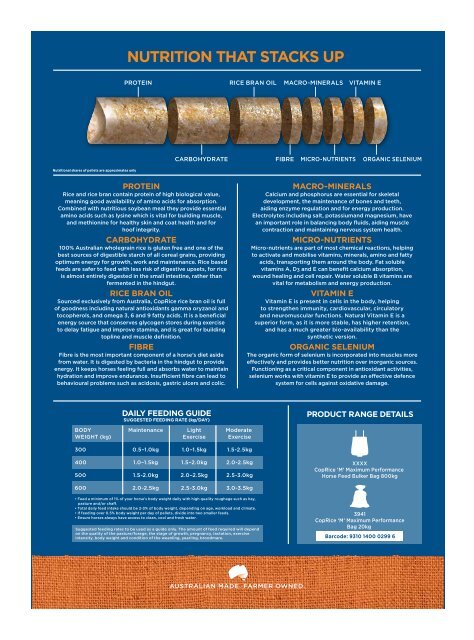You also want an ePaper? Increase the reach of your titles
YUMPU automatically turns print PDFs into web optimized ePapers that Google loves.
NUTRITION THAT STACKS UP<br />
PROTEIN<br />
RICE BRAN OIL<br />
MACRO-MINERALS<br />
VITAMIN E<br />
CARBOHYDRATE<br />
FIBRE<br />
MICRO-NUTRIENTS<br />
ORGANIC SELENIUM<br />
Nutritional shares of pellets are approximates only<br />
PROTEIN<br />
Rice and rice bran contain protein of high biological value,<br />
meaning good availability of amino acids for absorption.<br />
Combined with nutritious soybean meal they provide essential<br />
amino acids such as lysine which is vital for building muscle,<br />
and methionine for healthy skin and coat health and for<br />
hoof integrity.<br />
CARBOHYDRATE<br />
100% Australian wholegrain rice is gluten free and one of the<br />
best sources of digestible starch of all cereal grains, providing<br />
optimum energy for growth, work and maintenance. Rice based<br />
feeds are safer to feed with less risk of digestive upsets, for rice<br />
is almost entirely digested in the small intestine, rather than<br />
fermented in the hindgut.<br />
RICE BRAN OIL<br />
Sourced exclusively from Australia, CopRice rice bran oil is full<br />
of goodness including natural antioxidants gamma oryzanol and<br />
tocopherols, and omega 3, 6 and 9 fatty acids. It is a beneficial<br />
energy source that conserves glycogen stores during exercise<br />
to delay fatigue and improve stamina, and is great for building<br />
topline and muscle definition.<br />
FIBRE<br />
Fibre is the most important component of a horse’s diet aside<br />
from water. It is digested by bacteria in the hindgut to provide<br />
energy. It keeps horses feeling full and absorbs water to maintain<br />
hydration and improve endurance. Insufficient fibre can lead to<br />
behavioural problems such as acidosis, gastric ulcers and colic.<br />
MACRO-MINERALS<br />
Calcium and phosphorus are essential for skeletal<br />
development, the maintenance of bones and teeth,<br />
aiding enzyme regulation and for energy production.<br />
Electrolytes including salt, potassiumand magnesium, have<br />
an important role in balancing body fluids, aiding muscle<br />
contraction and maintaining nervous system health.<br />
MICRO-NUTRIENTS<br />
Micro-nutrients are part of most chemical reactions, helping<br />
to activate and mobilise vitamins, minerals, amino and fatty<br />
acids, transporting them around the body. Fat soluble<br />
vitamins A, D 3 and E can benefit calcium absorption,<br />
wound healing and cell repair. Water soluble B vitamins are<br />
vital for metabolism and energy production.<br />
VITAMIN E<br />
Vitamin E is present in cells in the body, helping<br />
to strengthen immunity, cardiovascular, circulatory<br />
and neuromuscular functions. Natural Vitamin E is a<br />
superior form, as it is more stable, has higher retention,<br />
and has a much greater bio-availability than the<br />
synthetic version.<br />
ORGANIC SELENIUM<br />
The organic form of selenium is incorporated into muscles more<br />
effectively and provides better nutrition over inorganic sources.<br />
Functioning as a critical component in antioxidant activities,<br />
selenium works with vitamin E to provide an effective defence<br />
system for cells against oxidative damage.<br />
DAILY FEEDING GUIDE<br />
SUGGESTED FEEDING RATE (kg/DAY)<br />
PRODUCT RANGE DETAILS<br />
BODY Maintenance Light Moderate<br />
WEIGHT (kg) Exercise Exercise<br />
300 0.5–1.0kg 1.0–1.5kg 1.5-2.5kg<br />
400 1.0–1.5kg 1.5–2.0kg 2.0-2.5kg<br />
500 1.5-2.0kg 2.0–2.5kg 2.5-3.0kg<br />
XXXX<br />
CopRice ‘M’ Maximum Performance<br />
Horse Feed Bulker Bag 800kg<br />
600 2.0-2.5kg 2.5-3.0kg 3.0-3.5kg<br />
• Feed a minimum of 1% of your horse’s body weight daily with high quality roughage such as hay,<br />
pasture and/or chaff.<br />
• Total daily feed intake should be 2-3% of body weight, depending on age, workload and climate.<br />
• If feeding over 0.5% body weight per day of pellets, divide into two smaller feeds.<br />
• Ensure horses always have access to clean, cool and fresh water.<br />
Suggested feeding rates to be used as a guide only. The amount of feed required will depend<br />
on the quality of the pasture/forage, the stage of growth, pregnancy, lactation, exercise<br />
intensity, body weight and condition of the weanling, yearling, broodmare.<br />
3941<br />
CopRice ‘M’ Maximum Performance<br />
Bag 20kg<br />
Barcode: 9310 1400 0299 6<br />
AUSTRALIAN MADE. FARMER OWNED.


